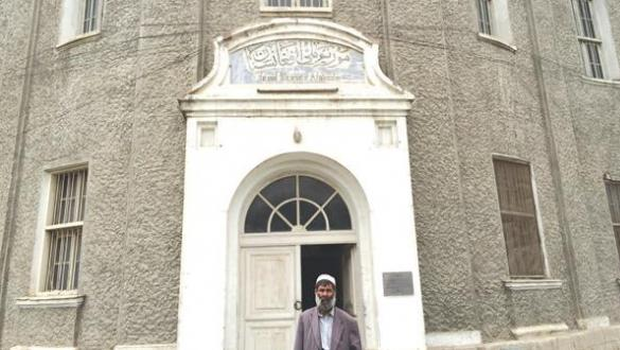
Omran Khan Massoudi, general manager of Afghanistan’s National Museum, stands in front of the museum’s entrance in Kabul, Afghanistan. (Asharq Al-Awsat)
Kabul, Asharq Al-Awsat—“Nations remain alive if they preserve their history and culture.” These are the words that greet visitors to Afghanistan’s National Museum, located near what remains of Kabul’s once-lavish Darulaman Palace, now lying in ruins after being damaged during the Soviet invasion in the 1980s and the civil war between jihadist factions in the country in the 1990s.
Omran Khan Massoudi, the museum’s director&38212;who has worked there in some capacity for 35 years—told Asharq Al-Awsat that around 70 percent of the museum’s then-100,000 items were looted during the civil war of 1992–1996. Countless—and priceless—artifacts were smuggled into neighboring countries, others finding their way further, now part of the global stolen antiquities trade. In 1993, Massoudi said, the museum’s roof was damaged in a mortar attack.
After the Taliban took the reins in 1996, things got even worse: The museum was almost closed down and many of its items destroyed—seen as “pagan idols” by the Taliban, who felt their interpretation of the Islamic Shari’a mandated the destruction of these vestiges of Afghanistan’s pre-Islamic past. Between 2,500 and 3,000 artifacts dating back to the 5th century CE were destroyed in just a few months.
However, Massoudi and his colleagues were determined to salvage what they saw as the country’s legitimate historical heritage. “Before the Taliban were in control of the capital city [Kabul], some of the museum’s employees and myself coordinated with officials from the Ministry of Culture to evacuate some valuable objects out of the museum and keep them in safe places,” he said. “This remained a secret between us, as we wanted to preserve Afghanistan’s antiquities, which are the property of the whole nation, and protect them against disappearance, theft or destruction.”
When the Taliban were forced out of power following the US-led war in 2002, the objects were safely returned to the museum. “When we realized that the [Taliban] regime was about to fall, we, alongside a group of officials, hid the . . . antiquities somewhere underground. In 2003, when the situation settled politically and security was restored, we took the items back to be displayed in the museum,” he said.
In recognition of his decades of service to the museum and his efforts in saving hundreds, if not more, of its priceless artifacts, Massoudi was appointed by the country’s Ministry of Culture and Information as the general manager of the museum in 2002.

Artifacts stand on display in Afghanistan’s National Museum, in Kabul, Afghanistan. (Asharq Al-Awsat)
After outgoing President Hamid Karzai came to power in 2004, a plan was drawn up to restore a number of the damaged items in the museum and find some of those that had been lost or smuggled. Around 500 damaged items were successfully restored to their former state and nearly 9,000 of those stolen or smuggled were recovered in cooperation with UNESCO and Interpol as well as the numerous countries—including the US, the UK, Norway, Denmark, Sweden, Germany and Iran—where the stolen artifacts were found.
In 2008, an exhibition of artifacts from the museum, “Afghanistan: Hidden Treasures from the National Museum, Kabul,” was held at the National Gallery of Art in Washington, DC, in cooperation with National Geographic, which called the National Museum’s roster of items, “a collection of some of the most remarkable archaeological finds in all of Central Asia.”
Massoudi said: “Now this collection is moving from one European capital to another to be exhibited in European countries. By exhibiting this collection, we say to the entire world that Afghanistan is not all wars, suicide [bombings] or explosions, it also has a history and an ancient civilization.” Since the first exhibition of the museum’s treasures took place in Paris, there have been further shows in Italy, the Netherlands, the United Arab Emirates, Canada, Germany, the US, the UK, and now, Australia.
But Massoudi believes the collection could be even more impressive if the country’s government were to funnel more resources into antiquities. “Afghanistan is full of artifacts that are buried underground and need to be extracted in a technical and professional manner,” he said. “There are vast areas which we know contain valuable antiquities dating back to the Stone Age . . . Unfortunately though, nearly 1,200 archeological sites are currently endangered due to the government’s poor control over these areas, where armed groups steal antiquities to sell them on the [stolen antiquities] market.”
Most objects at the National Museum date back about 3,000 years, with some reaching back as far as 5,000 years. Others were discovered in what was historically known as Bactria—northern Afghanistan. However, most objects in the museum’s collection came from Nuristan, a rugged mountainous area in northeastern Afghanistan that used to be called Kafiristan (literally, “the Land of the Infidels”) at the time of Prince Abdulrahman Khan in the 19th century, and populated by the Kalash, an indigenous Dardic people with their own language and distinctive religion influenced by the ancient Vedic religion, a precursor to modern Hinduism. After many of the Kafiristan population converted to Islam, the name was changed to Nuristan—literally, “the Land of Light”—which is how it is known today. Massoudi said this was a history Afghans were proud to have, one showcasing the country’s historical diversity of cultures and religions—something the Taliban had sought to blot out.
Afghanistan is now entering a new phase with the country seeking to elect a new president and foreign countries withdrawing their troops after a presence of more than a decade. Massoudi sees the country, with its long and dynamic history, offering something valuable to the global community. “I’m optimistic that Afghanistan will restore its historic stature in the region and the world in terms of its ability to collect, exhibit and preserve its antiquities. In fact, such objects are the common heritage of all humanity,” he said.
